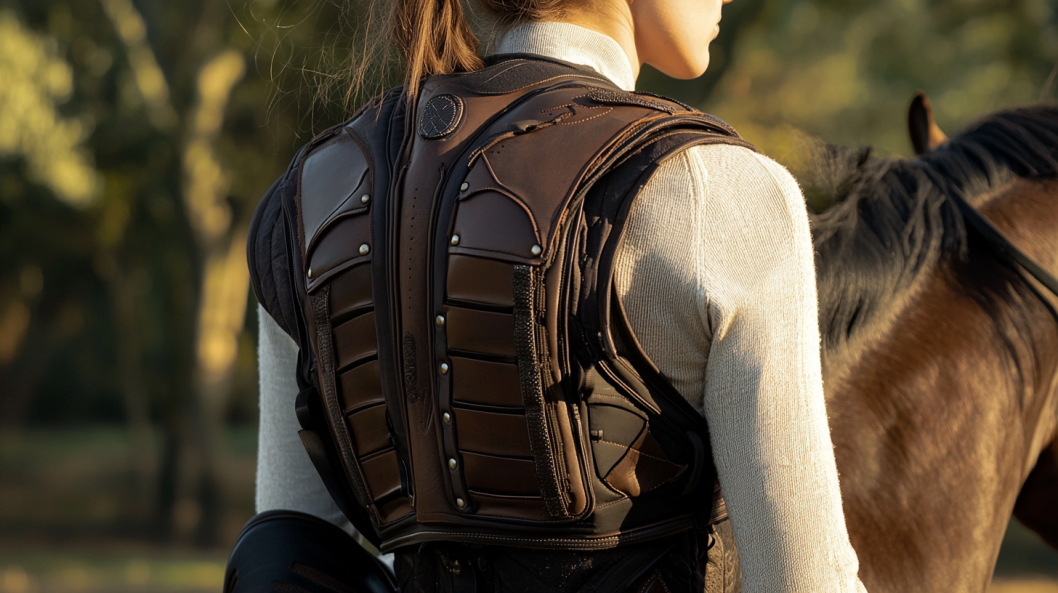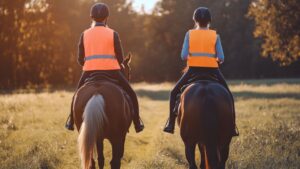Horseback riding has always been risky. With every ride, equestrians take on the unpredictable nature of horses—majestic yet strong animals that, by instinct, react suddenly to their surroundings. For years, helmets have been considered a staple of equestrian safety gear, but more recently, safety vests have become essential for riders, too.
I firmly believe that integrating safety vests into horseback riding is not just a trend but a necessary evolution in rider protection. Here, we’ll explore the impact of safety vests on horseback riding, examining how they contribute to rider confidence, injury prevention, and the overall riding experience.
1. Enhancing Rider Confidence
One of the first effects of wearing a safety vest is its boost to rider confidence. Confidence in horseback riding is critical, as horses are highly intuitive animals that often sense when their riders are tense or fearful. Safety vests provide riders with an added layer of security, allowing them to feel more assured in the saddle. This confidence helps riders communicate better with their horses, relax their posture, and enjoy a smoother, safer ride. A vest’s reassurance can be particularly beneficial for beginners or those recovering from a previous fall.
2. Reducing Injury Severity
In the unfortunate event of a fall or collision, safety vests play a vital role in reducing the severity of injuries. Falls from a horse can result in significant trauma, particularly to the rider’s chest, back, and abdomen. Safety vests are designed with impact-absorbing materials that distribute and cushion the force of a fall, decreasing the likelihood of fractures, spinal injuries, and bruising to vital organs.
There are two main types of safety vests commonly used in equestrian sports:
- Standard Safety Vests: These are made from shock-absorbent foam and provide consistent protection to the torso. They meet rigorous safety standards and offer extensive coverage, particularly around the ribs, back, and collarbone.
- Air Vests: Newer, innovative vests deploy air cushioning upon impact. A small compressed air canister inflates the vest when the rider is unseated from the saddle, creating an additional layer of shock absorption that can significantly reduce injury to the spine and internal organs.
3. Improved Rider and Horse Safety Across Equestrian Disciplines
Safety vests are becoming increasingly popular in a range of equestrian disciplines. While once mainly associated with eventing and cross-country riding due to their higher risk of falls and jumps, vests are now being adopted by riders in other fields, including show jumping, trail riding, and dressage. Riders across disciplines recognize that unpredictable accidents can happen in any riding environment, whether in an arena or on a quiet trail.
Youth and beginner riding programs also encourage the regular use of safety vests. Riding schools and trainers often recommend vests for their students, as the added protection reduces the potential for serious injury, especially as beginners learn to control and communicate with their horses.
4. Technological Advancements in Vest Design
Safety vest technology has advanced greatly, moving beyond bulky, restrictive designs to more flexible, breathable materials that allow freedom of movement. Modern vests are designed to follow the contours of the rider’s body, providing a comfortable fit while maintaining high safety standards. Many now come with adjustable features and lightweight materials, enabling riders to move naturally in the saddle.
The development of air vests is particularly notable, as they have become an option for even recreational riders. These vests are compact when not inflated and expand only in the event of a fall, making them practical for daily use. With constant improvements in vest technology, safety is no longer synonymous with discomfort; vests have become a seamless part of a rider’s gear.
5. Raising Awareness and Changing the Culture Around Safety Gear
The increased popularity of safety vests has also spurred important conversations about safety in the equestrian world. Helmets were once the only widely accepted piece of safety equipment for riding, but the rise of vests has brought additional awareness to other potential hazards. Wearing a safety vest gradually becomes as normalized as wearing a helmet, creating a culture where safety is paramount.
This cultural shift is particularly evident at competitions and organized events, where safety vest regulations are often in place. Many eventing competitions, for example, now require safety vests for certain stages, making them as standard as helmets for participants.
6. Limitations and Considerations
While safety vests offer invaluable protection, they are not a cure-all solution. For one, they are not designed to prevent all types of injuries; instead, they reduce the impact of falls rather than eliminating injury risks. Additionally, some riders may find certain vests cumbersome, especially in warm weather or requiring a full range of motion for specific disciplines.
Riders should select a vest that meets recognized safety standards and is appropriate for their discipline to ensure optimal performance. Proper fit is also crucial: a vest should be snug but not restrictive, allowing freedom of movement without compromising protection.
The impact of safety vests on horseback riding has been undeniably positive. As protective technology evolves, vests offer riders more confidence, reduced risk of severe injury, and an improved overall riding experience. They are increasingly becoming a must-have for equestrians of all levels, providing peace of mind that allows riders to focus on their connection with their horses. Embracing safety vests in horseback riding culture is a vital step toward fostering a safer environment for riders of all ages and disciplines, helping to ensure that the sport remains as enjoyable as it is adventurous.





